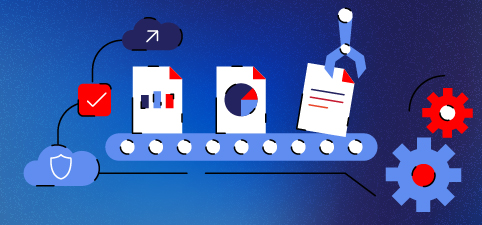What is Workflow Automation?
Workflow automation can be defined as a set of repeatable activities that lead up to a common output, a complete process. Figuring out what needs to be automated is really a process of understanding the organization’s procedures and automating them. It might be something simple like documents that must go through four or five different layers of approvals. Usually that’s accomplished by having someone send emails with the documents attached to each signer in turn. But, that’s a simple workflow to automate where an email goes to the first approver and then on to the next person in line—without an employee needing to do it manually.
There can be more complex workflows with multiple different systems for sharing, processing, or managing data from one system into another. But workflow automation can ensure that an employee doesn’t have to manually pull data out of a database or connect two different systems. Instead it understands the business process, what the organization does day to day, performs the repeatable steps, and automates the process flow.
Benefits of Workflow Automation
One mundane task that can be automated is filling out forms. It benefits an organization to increase the speed and ease of use for the consumers and employees who need to fill out forms. If you’re dealing with a lot of people, the savings start to scale very quickly. The benefit can be monetary, saving time, reducing labor—or all of the above.
Workflow automation can help prefill the form, whether someone is completing a common form they have filled out previously or a new form that they’re completing for the first time. The user only needs to verify the information. It’s a huge time saver, and everyone loves that user experience.
There are more complicated and creative uses for workflow automation. If you have people creating imagery, videos, or other content for the web, you can centralize it in one place with a digital asset management tool. Workflow automation adds metadata and tags, helps report commonly used items, and aids in searches and the overall performance of retrieving content. Thus, it organizes and centralizes everything.
Benefits and Trends during the Pandemic
 Workflow automation has been making life a lot easier during the pandemic. The Air Force, for example, has a lot of airmen who are working from home and aircraft manufacturers that had been on base who must now send forms for aircraft parts online. Also, the Air Force has to recruit new candidates without storefront offices or recruiting conferences where they give presentations.
Workflow automation has been making life a lot easier during the pandemic. The Air Force, for example, has a lot of airmen who are working from home and aircraft manufacturers that had been on base who must now send forms for aircraft parts online. Also, the Air Force has to recruit new candidates without storefront offices or recruiting conferences where they give presentations.
There’s been a huge expansion in workflow automation for those types of audiences. The Air Force has to envision its candidates as customers who are potentially interested—and now you have to sell to them. A potential airman goes online and wants to see what the Air Force has to offer. Workflow automation allows the system to personalize that experience
Automation personalizes the recruiting experience to keep the candidate interested and moving through the process, even leading up to filling out the candidate form. Furthermore, it generates leads and helps transfer the data to backend databases and systems such as a CRM system for recruiters—who can work through the leads and follow up. Automation can be a key element to ensure their recruiting workflows are generating qualified leads.
Workflow Automation to Keep Documents Moving
With the pandemic, more of the Air Force’s internal processes must be done remotely. They need collaboration, virtual meetings, filling out forms, and other processes at a much greater scale. They must share knowledge internally before even producing external content.
It became even more important to have some workflows that could keep things moving and make data-sharing easier—to create reports or provide content and data intelligence. They’ve been figuring out how they can make better decisions by using the available data. Workflow automation is the underlying foundation to enable that process.
Moving documentation across the Air Force is incredibly important for its policy and publications workflows to function properly. An aircraft part is important to a maintainer and a well-maintained aircraft is important to a pilot. It takes a lot of forms and coordination, with data moving around, to keep airplanes flying. An intensely manual process such as filling out forms for shipping and inspecting parts can now be handled easily on mobile devices.
Air Force Publications
Another example of workflow automation is Air Force publications: policy or governance files that basically define all of the policies around anything and everything Air Force. They have 10,000+ people globally as content creators, authors, editors, and reviewers. When a publication is created, it is worked on by many different people in different organizations—with strict governance because creating a policy means it has to go through multiple levels of approval.
It must be seamless and easy because spending too much time wastes manpower and money. They also have multiple authors for editorial reviews or co-authoring with multiple people on the same publication—as well as issues with managing version control.
They needed to find a simple, intuitive, and easy system to produce these publications. So they set up workflow automation with a content management system and were blown away about what could be automated. They could drastically reduce the number of emails being sent, take care of version management, prevent documents from getting lost, etc.
They leveraged a simple, intuitive user interface, where airmen could have appropriate roles and permissions and define the requirements for the publication so everybody could work on it collaboratively. The result impacts the entire Air Force—and all of its policies and publications. It’s also repeatable across the DoD. Thus, it presents an opportunity for the larger DoD to take what the Air Force is doing and adapt it to save an immense amount of time and money.
Listen to our Podcast to hear our more in-depth conversation about workflow automation, its importance over the last year and what we can expect to see in 2021.








